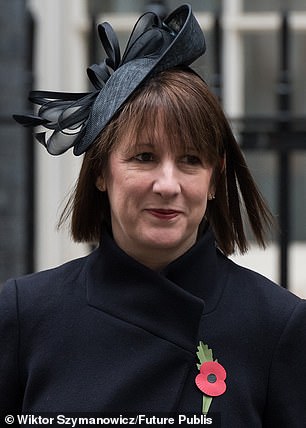Table of Contents
Pension reforms: Rachel Reeves wants to unlock £80bn for investment in business and infrastructure, boost people’s retirement funds and drive growth
A government plan to use people’s pension savings to boost economic growth has broad public support, new research reveals.
Speaking at Mansion House tonight, Chancellor Rachel Reeves will announce the creation of pension ‘mega funds’, forcing mergers of smaller local authorities and private schemes to unlock £80bn of new investment.
Some 57 per cent of people want their pension to include a higher percentage of shares in UK companies, although 42 per cent said this was on the condition that it would not affect investment returns.
Meanwhile, 54 percent want their pensions to be invested more in private assets such as housing schemes, infrastructure projects and early growth companies, according to Abrdn’s survey.
Their survey of 3,000 people, weighted to be nationally representative, found that 14 percent did not want this and 32 percent were unsure.
The Chancellor’s plan to use pensions to boost growth is explained below, and builds on his predecessor Jeremy Hunt’s initiative in last year’s Mansion House speech to unlock additional cash in pensions to support the economy.
Hunt claimed his suite of plans – including getting major pension firms to allocate 5 per cent of their “default” workplace funds to unlisted shares – would see the typical saver earn £1,000 a year in retirement.
What does the Chancellor’s pension reform entail?
Rachel Reeves plans to create pension ‘mega funds’ by consolidating defined contribution schemes below a certain size and pooling assets from the 86 independent Local Government Pension Scheme authorities.
She says this will unlock £80 billion of investment in exciting new businesses, infrastructure and local projects, while boosting retirement savings and driving economic growth to improve people’s lives.
The Treasury says the mega funds will be similar to those set up in Australia and Canada, where pension funds use their size to invest in assets with greater growth potential.
“Canada pension plans invest about four times more in infrastructure, while Australian pension plans invest about three times more in infrastructure and 10 times more in private capital, such as companies, compared to contribution plans of the United Kingdom,” according to the Treasury.
It notes that there are currently around 60 different ‘multi-employer’ defined contribution pension schemes and seeks to set a minimum size requirement for them to ensure they meet their investment potential.
The Government will hold a consultation on the reforms, which will then be introduced in a new pension schemes bill next year.
All risks will be taken with the money of pension savers
“My main concern is that the needs of the saver, whose money is ultimately going to be risked, are forgotten,” says Tom Selby, director of public policy at AJ Bell.
‘There is a reason why an occupational scheme has an administrator who looks after the interests of its members. Part of that is investing your money to maximize returns and get the best possible outcomes in retirement.”
“Conflating the Government’s aim to boost investment in the UK and people’s retirement outcomes is dangerous because all the risks are taken on members’ money.”
Selby says it is necessary to make it clear to pension scheme members what is happening to their money.
It notes that trustees of defined contribution default funds and defined benefit plans must make investment decisions “first and foremost” with the goal of generating the highest possible income during members’ retirement.
‘Therefore, good outcomes for members are at the heart of the UK pension system. Given that we are probably talking about pensions where the member is disengaged in the case of defined contribution defaults or has no say over investment decisions in the case of defined benefits, it is crucial that this remains the case.’
Selby adds: “If everything goes well, everyone will be able to celebrate.” But it is clearly possible that it could be the other way around, so some caution is needed in this attempt to use other people’s money to boost economic growth.’
Mega funds will need a portfolio of viable investments
The success of merging local authority pension funds so that they are large enough to access high-return investments will largely depend on the availability of new infrastructure projects to invest in, according to Jon Greer, head of policy Quilter’s retirement plan.
“It’s the chicken and egg dilemma. Large funds need substantial and reliable projects to generate returns, but the market may struggle to offer enough such opportunities, especially in the infrastructure sector,’ he says.
‘If too much money chases too few viable investments, the effectiveness of this consolidation could be diluted, with funds potentially tied to riskier or less impactful projects.
“The Government will need to work actively to develop a portfolio of investment opportunities that align with the mega funds’ scale and risk requirements.”
Greer adds that better oversight and regulation is welcome, but additional levels of scrutiny could cause mega funds to move slowly and be saddled with compliance costs that ultimately affect returns.
‘It is also noteworthy that Reeves has stopped short of requiring pension schemes to invest a fixed portion of their assets in UK stocks or infrastructure projects, but has instead encouraged specific targets for the fund’s investment in the economy. local.
“While driving investment towards the UK is beneficial, such mandates could have restricted the ability of pension schemes to make dynamic, performance-focused decisions.”
Greer continues: “Reeves’ plan to support the UK economy is well-intentioned, but it is vital to balance it with the devolution schemes needed to protect savers’ financial future.”
Some links in this article may be affiliate links. If you click on them, we may earn a small commission. That helps us fund This Is Money and keep it free to use. We do not write articles to promote products. We do not allow any commercial relationship to affect our editorial independence.


